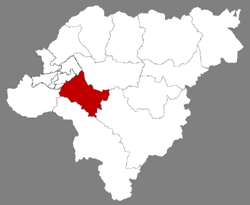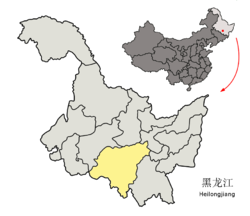مديرية آتشنگ
آتشنگ
阿城区 Acheng | |
|---|---|
 موقع آتشنگ في هاربين | |
 هاربين في خـِيْلونگجيانگ | |
| الإحداثيات: 45°32′12″N 126°58′02″E / 45.5368°N 126.9671°E | |
| البلد | |
| المقاطعة | خـِيْلونگجيانگ |
| Sub-provincial city | هاربين |
| التقسيمات | 9 subdistricts 8 بلدات 1 بلديات 1 بلديات عرقية |
| المقر | Jincheng Subdistrict (金城街道) |
| المساحة | |
| • الإجمالي | 2٬452٫1 كم² (946٫8 ميل²) |
| التعداد | |
| • الإجمالي | 596٬856 |
| • الكثافة | 240/km2 (630/sq mi) |
| منطقة التوقيت | UTC+8 (China Standard) |
| Postal code | 1503XX |
| مفتاح الهاتف | 0451 |
| مديرية آتشنگ | |||||||
|---|---|---|---|---|---|---|---|
| الصينية التقليدية | 阿城區 | ||||||
| الحروف المبسطة | 阿城区 | ||||||
| |||||||
| Manchu name | |||||||
| Romanization | Alchuka | ||||||
مديرية آتشنگ Acheng District؛ سابقاً مدينة آتشنگ، (Manchu Language : Alcuka Hoton) هي واحدة من تسع مديريات المدينة بمستوى محافظة هاربين، عاصمة مقاطعة خـِيْلونگجيانگ، شمال شرق الصين، تغطي جزء من الضواحي الجنوبية الشرقية. The district was approved to establish from the former Acheng City (阿城市) by the Chinese State Council on August 15, 2006.[3] اعتبارا من 2010[تحديث], it had a population of 596,856 residing in an area of 2،680 km2 (1،030 sq mi)[note 1],[1] and is 29 km (18 mi) southeast of downtown Harbin, 190 km (120 mi) north of Jilin City, and around 50 km (31 mi) south of the Songhua River. It lies within the basin of and until 1909 was considered synonymous with the Ashi River[5] which gave its name to the Jurchen Jin أسرة. The district administers nine subdistricts, eight towns, one township, and one ethnic township. It borders Daowai District to the north, Bin County to the northeast, Shangzhi to the southeast, and Wuchang to the south, Shuangcheng District to the west, and Pingfang and Xiangfang Districts to the northwest.
التاريخ
Acheng was known to medieval China as Huining Prefecture, an area of Shangjing. Its eponymous seat served as the first capital of the Jurchen Jin Dynasty (1122–1234) and served as a subsidiary capital from 1173 until their conquest by the Mongolian Empire.[5] There is currently a museum at the site, about 2 km (1.2 mi) south of the Acheng urban area.
Acheng County was established in 1909. It was designated a county-level city in 1987 and turned into a district of Harbin on October 9, 2006.[6]
التعداد
| السنة | تعداد الحضر | إجمالي التعداد |
|---|---|---|
| 1989[5] | 188,600 | |
| 1994[1] | 219,500 | 631,700 |
| 2010 | 596,856 |
التقسيمات الادارية
Acheng is divided into nine subdistricts, eight towns, one township, and one ethnic township:[7]
دون المديريات:
- Jincheng Subdistrict (金城街道), Jindu Subdistrict (金都街道), Tongcheng Subdistrict (通城街道), Hedong Subdistrict (河东街道), Ashihe Subdistrict (阿什河街道), Sheli Subdistrict (舍利街道), Xinli Subdistrict (新利街道), Shuangfeng Subdistrict (双丰街道), Yuquan Subdistrict (玉泉街道)
البلدات:
- Feiketu (蜚克图镇), Jiaojie (交界镇), Xiaoling (小岭镇), Pingshan (平山镇), Yagou (亚沟镇), Songfengshan (松峰山镇), Hongxing (红星镇), Jinlongshan (金龙山镇)
البلديات:
- Yangshu Township (杨树乡), Liaodian Manchu Ethnic Township (料甸满族乡)
التجارة
The area is rich in mineral resources, including sources of rock, volcanic rock, granite, molybdenum, zinc, lead, iron,[1] and copper.
The agricultural strengths of the area are grain production and cattle.[1] Grain production is strong, having produced 33,100 tons of grain in 2002; much of this grain is essential in feeding the important city of Harbin.
Acheng is a major industrial area for Heilongjiang, with over 300 types of enterprises, including textile,[1] electromechanics, food, building materials[1] (especially brickworks), metallurgy, breweries fueled by the local grain, sugar refineries, a flax plant,[5] iron, steel,[1] and the production of medicine. In 1996 a new technology industrial development zone was created on the western side of the city to encourage the development of high technology, export-oriented industry.
Tourism is also a growing part of the local economy. Acheng is located on the popular tourist route serving Harbin, the Yabuli ski resort, Lake Jingpo, and Xingkai Lake. A number of historic and nature reserves in the area also attract visitors.
النقل
The city of Acheng is a 50 km (31 mi) drive from Harbin Taiping International Airport.
The Harbin–Suifenhe Railway (part of the original Chinese Eastern Railway) passes through the district. There are over twenty commuter rail lines in the rural area. The station is Acheng Railway Station.
G10 Suifenhe–Manzhouli Expressway and China National Highway 301 both connect the district to downtown Harbin.
أشخاص بارزون
- Huang Taihua: artist born in Acheng (1947), director of the Academy of Fine Arts of Acheng, director of the Heilongjiang Artists Association.
- Zhao Weichen: President of China Unicom, born in Acheng (1929)
ملاحظات
المراجع
الهامش
- ^ أ ب ت ث ج ح خ د Cohen 1998, p. 12
- ^ 2010 Census Harbin primary statistics report (《哈尔滨市2010年第六次全国人口普查主要数据公报》). Accessed 8 July 2014.
- ^ 国务院关于同意黑龙江省调整哈尔滨市部分行政区划的批复(国函〔2006〕73号) (in الصينية المبسطة). gov.cn. 2006-08-15. Retrieved 2019-07-22.
- ^ Ming 2011
- ^ أ ب ت ث Hoiberg 2010, p. 1
- ^ 哈尔滨日报 (2006). 哈尔滨市撤销阿城市 设立阿城区_振兴东北 (in الصينية). 哈尔滨日报. Archived from the original on 2008-09-05. Retrieved 2015-08-17.
- ^ Anon 2012[dead link]
ببليوگرافيا
- Cohen, Saul B., ed. (1998) [1952]. "Acheng". The Columbia Gazetteer of the World. New York, NY: Columbia University Press. ISBN 0-231-11040-5.
- "Acheng, Harbin, Heilongjiang, China, 150300" (Map). Google Maps. 2014. Retrieved 31 Jul 2014.
- Hoiberg, Dale H., ed. (2010). "A-ch'eng". Encyclopædia Britannica. Vol. I: A-Ak – Bayes (15th ed.). Chicago, Illinois: Encyclopædia Britannica, Inc. ISBN 978-1-59339-837-8.
- Ming, Ben She. Yi (2011). Harbin Statistical Yearbook 2011 (الصينية: 《哈尔滨统计年鉴2011》). China Statistics Press. ISBN 978-7-5037-6314-4.
- Anon (2012). 2011年统计用区划代码和城乡划分代码:阿城区 (in الصينية). National Bureau of Statistics of the People's Republic of China. Archived from the original on November 5, 2013. Retrieved 2013-01-25.
وصلات خارجية
- Pages using gadget WikiMiniAtlas
- Articles containing simplified Chinese-language text
- CS1 uses الصينية-language script (zh)
- CS1 الصينية المبسطة-language sources (zh-hans)
- CS1 الصينية-language sources (zh)
- Articles with dead external links from July 2014
- Short description is different from Wikidata
- Articles containing صينية-language text
- Coordinates on Wikidata
- مقالات بالمعرفة تحتاج تمحيص الحقائق from July 2014
- جميع الصفحات التي تحتاج تمحيص حقائق
- مقالات فيها عبارات متقادمة منذ 2010
- جميع المقالات التي فيها عبارات متقادمة
- مدن خـِيْلونگجيانگ
- مديريات هاربين